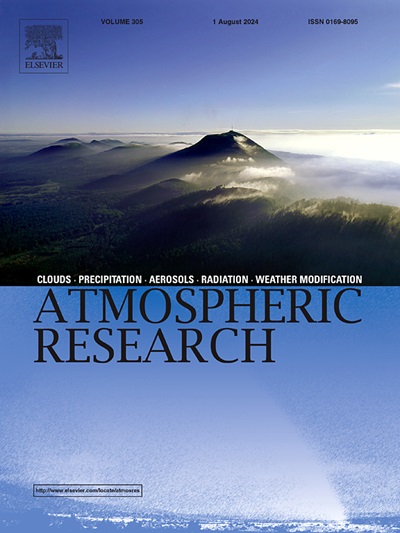Vertical structure of the aerosols in the troposphere over the North China Plain: An analysis based on observations and simulations from 2007 to 2022
IF 4.4
2区 地球科学
Q1 METEOROLOGY & ATMOSPHERIC SCIENCES
引用次数: 0
Abstract
This study systematically investigates the vertical structure characteristics and driving mechanisms of tropospheric aerosols over the North China Plain (NCP) based on Cloud-Aerosol Lidar with Orthogonal Polarization (CALIOP) aerosol profiles from 2007 to 2022, combining K-means clustering, regression analysis, and Weather Research and Forecasting with Chemistry model (WRF-Chem) simulations. Seasonal cluster analysis identified four typical vertical structures during daytime, with the Elevated Aerosol Layer (EAL) in summer being the most prominent. Significant aerosol accumulation occurs within the 500–1500 m height range during this season, contributing nearly 50 % of the tropospheric Aerosol Optical Depth (AOD). Analysis of long-term CALIOP data further revealed a significant decreasing trend in AOD over the study region between 2013 and 2020, a change closely linked to emission reduction policies implemented during the same period. To delve deeper into the causes of the aerosol accumulation phenomenon at 500–1500 m and the influencing factors and vertical distribution characteristics of the AOD decline, we designed WRF-Chem sensitivity experiments combined with regression analysis. The results indicate that both emission factors and meteorological factors influence AOD, but their dominance varies with height: emissions primarily affect near-surface aerosols below 500 m, while meteorology dominates the variations at heights of 500–1500 m. Specifically, hygroscopic growth, thermal convection, bounce and resuspension of coarse particles, and long-range transport collectively enhance aerosol accumulation at 500–1500 m. Consequently, policy-driven emission reductions significantly lowered near-surface aerosol concentrations, which is crucial for mitigating population exposure risks. However, the aerosol accumulation phenomenon at 500–1500 m persists regardless of emission changes, as it is primarily driven by meteorological factors.
华北平原对流层气溶胶垂直结构:基于2007 - 2022年观测和模拟的分析
基于云-气溶胶激光雷达正交偏振(CALIOP)气溶胶剖面,结合K-means聚类、回归分析和WRF-Chem模拟,系统研究了2007 - 2022年华北平原对流层气溶胶垂直结构特征及其驱动机制。季节聚类分析发现白天有4种典型的垂直结构,其中以夏季高架气溶胶层(EAL)最为突出。在这个季节,在500-1500 m高度范围内发生了显著的气溶胶积累,贡献了对流层气溶胶光学深度(AOD)的近50%。对长期CALIOP数据的分析进一步揭示了2013 - 2020年研究区域AOD的显著下降趋势,这一变化与同期实施的减排政策密切相关。为深入研究500 ~ 1500 m气溶胶积累现象的成因以及AOD下降的影响因素和垂直分布特征,我们设计了WRF-Chem敏感性实验,并结合回归分析。结果表明:大气排放因子和气象因子对AOD均有影响,但其影响程度随高度不同而不同:大气排放主要影响500 m以下近地表气溶胶,而气象因子在500 ~ 1500 m高度的变化中占主导地位。具体而言,吸湿生长、热对流、粗颗粒的反弹和重悬浮以及远距离输送共同增强了500-1500 m的气溶胶积累。因此,政策驱动的减排显著降低了近地表气溶胶浓度,这对减轻人口暴露风险至关重要。然而,无论排放变化如何,500-1500 m的气溶胶积累现象仍然存在,这主要是由气象因子驱动的。
本文章由计算机程序翻译,如有差异,请以英文原文为准。
求助全文
约1分钟内获得全文
求助全文
来源期刊

Atmospheric Research
地学-气象与大气科学
CiteScore
9.40
自引率
10.90%
发文量
460
审稿时长
47 days
期刊介绍:
The journal publishes scientific papers (research papers, review articles, letters and notes) dealing with the part of the atmosphere where meteorological events occur. Attention is given to all processes extending from the earth surface to the tropopause, but special emphasis continues to be devoted to the physics of clouds, mesoscale meteorology and air pollution, i.e. atmospheric aerosols; microphysical processes; cloud dynamics and thermodynamics; numerical simulation, climatology, climate change and weather modification.
 求助内容:
求助内容: 应助结果提醒方式:
应助结果提醒方式:


